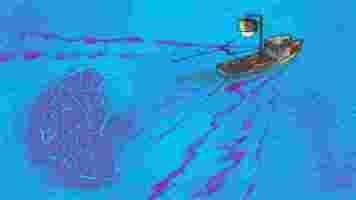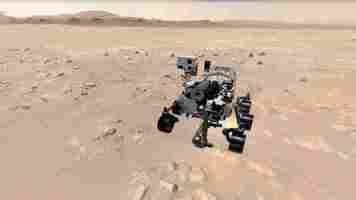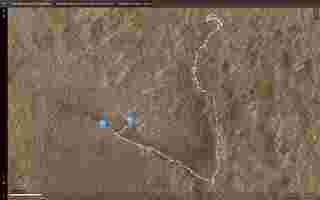This manual for a popular facial recognition tool shows just how much the software tracks people

In 2019, the Santa Fe Independent School District in Texas ran a weeklong pilot program with the facial recognition firm AnyVision in its school hallways. With more than 5,000 student photos uploaded for the test run, AnyVision called the results “impressive” and expressed excitement at the results to school administrators.
“Overall, we had over 164,000 detections the last 7 days running the pilot. We were able to detect students on multiple cameras and even detected one student 1100 times!” Taylor May, then a regional sales manager for AnyVision, said in an email to the school’s administrators.
The number gives a rare glimpse into how often people can be identified through facial recognition, as the technology finds its way into more schools , stores, and public spaces like sports arenas and casinos.
May’s email was among hundreds of public records reviewed by The Markup of exchanges between the school district and AnyVision, a fast-growing facial recognition firm based in Israel that boasts hundreds of customers around the world , including schools, hospitals, casinos, sports stadiums, banks, and retail stores. One of those retail stores is Macy’s, which uses facial recognition to detect known shoplifters , according to Reuters. Facial recognition, purportedly AnyVision, is also being used by a supermarket chain in Spain to detect people with prior convictions or restraining orders and prevent them from entering 40 of its stores, according to research published by the European Network of Corporate Observatories .
Neither Macy’s nor supermarket chain Mercadona responded to requests for comment.
The public records The Markup reviewed included a 2019 user guide for AnyVision’s software called “Better Tomorrow.” The manual contains details on AnyVision’s tracking capabilities and provides insight on just how people can be identified and followed through its facial recognition.
The growth of facial recognition has raised privacy and civil liberties concerns over the technology’s ability to constantly monitor people and track their movements. In June, the European Data Protection Board and the European Data Protection Supervisor called for a facial recognition ban in public spaces , warning that “deploying remote biometric identification in publicly accessible spaces means the end of anonymity in those places.”
Lawmakers, privacy advocates, and civil rights organizations have also pushed against facial recognition because of error rates that disproportionately hurt people of color. A 2018 research paper from Joy Buolamwini and Timnit Gebru highlighted how facial recognition technology from companies like Microsoft and IBM is consistently less accurate in identifying people of color and women.
In December 2019, the National Institute of Standards and Technology also found that the majority of facial recognition algorithms exhibit more false positives against people of color . There have been at least three cases of a wrongful arrest of a Black man based on facial recognition .
“Better Tomorrow” is marketed as a watchlist-based facial recognition program, where it only detects people who are a known concern. Stores can buy it to detect suspected shoplifters, while schools can upload sexual predator databases to their watchlists, for example.
But AnyVision’s user guide shows that its software is logging all faces that appear on camera, not just people of interest. For students, that can mean having their faces captured more than 1,000 times a week.
And they’re not just logged. Faces that are detected but aren’t on any watchlists are still analyzed by AnyVision’s algorithms, the manual noted. The algorithm groups faces it believes belong to the same person, which can be added to watchlists for the future.
AnyVision’s user guide said it keeps all records of detections for 30 days by default and allows customers to run reverse image searches against that database. That means that you can upload photos of a known person and figure out if they were caught on camera at any time during the last 30 days.
The software offers a “Privacy Mode” feature in which it ignores all faces not on a watchlist, while another feature called “GDPR Mode” blurs non-watchlist faces on video playback and downloads. The Santa Fe Independent School District didn’t respond to a request for comment, including on whether it enabled the Privacy Mode feature.
“We do not activate these modes by default but we do educate our customers about them,” AnyVision’s chief marketing officer, Dean Nicolls, said in an email. “Their decision to activate or not activate is largely based on their particular use case, industry, geography, and the prevailing privacy regulations.”
AnyVision boasted of its grouping feature in a “Use Cases” document for smart cities, stating that it was capable of collecting face images of all individuals who pass by the camera. It also said that this could be used to “track [a] suspect’s route throughout multiple cameras in the city.”
The Santa Fe Independent School District’s police department wanted to do just that in October 2019, according to public records.
In an email obtained through a public records request, the school district police department’s Sgt. Ruben Espinoza said officers were having trouble identifying a suspected drug dealer who was also a high school student. AnyVision’s May responded, “Let’s upload the screenshots of the students and do a search through our software for any matches for the last week.”
The school district originally purchased AnyVision after a mass shooting in 2018 , with hopes that the technology would prevent another tragedy. By January 2020, the school district had uploaded 2,967 photos of students for AnyVision’s database.
James Grassmuck, a member of the school district’s board of trustees who supported using facial recognition, said he hasn’t heard any complaints about privacy or misidentifications since it’s been installed.
“They’re not using the information to go through and invade people’s privacy on a daily basis,” Grassmuck said. “It’s another layer in our security, and after what we’ve been through, we’ll take every layer of security we can get.”
The Santa Fe Independent School District’s neighbor, the Texas City Independent School District, also purchased AnyVision as a protective measure against school shootings. It has since been used in attempts to identify a kid who had been licking a neighborhood surveillance camera, to kick out an expelled student from his sister’s graduation, and to ban a woman from showing up on school grounds after an argument with the district’s head of security, according to WIRED .
“The mission creep issue is a real concern when you initially build out a system to find that one person who’s been suspended and is incredibly dangerous, and all of a sudden you’ve enrolled all student photos and can track them wherever they go,” Clare Garvie, a senior associate at the Georgetown University Law Center’s Center on Privacy & Technology, said. “You’ve built a system that’s essentially like putting an ankle monitor on all your kids.”
This article by Alfred Ng was originally published on The Markup and was republished under the Creative Commons Attribution-NonCommercial-NoDerivatives license.
Explore Mars in 3D with NASA’s new interactive tools
Did you know Neural is taking the stage this fall ? Together with an amazing line-up of experts, we will explore the future of AI during TNW Conference 2021. Secure your ticket now !

NASA has added a pair of interactive experiences to the enthralling array of sights and sounds generated from the Mars 2020 mission.
The new tools let you explore the planet from the comfort of your home.
In one, called “ Explore with Perseverance ,” you can follow the voyage of NASA’s car-shaped rover through a 3D simulation of the planet.
You can find, for instance, the spot where Perseverance landed on Mars and the flight zone of the Ingenuity helicopter.
The system is a modified version of NASA’s Advanced Science Targeting Tool for Robotic Operations (ASTTRO), which is used to select points of interest for Perseverance to study.
The landscape it depicts was built by stitching together images captured by the buggy and a NASA Orbiter flying over the red planet. As the rover rolls across the rugged Martian surface, the pictures it takes are mapped onto the terrain. Additional data collected by the Mars Reconnaissance Orbiter’s HiRISE camera then fills in the gaps.
Parker Abercrombie, who leads the software development at NASA’s Jet Propulsion Laboratory, said the team plans to add new sights as they’re discovered by the orbiter and rover:
NASA’s second new interactive experience is “ Where Is Perseverance? ” As the name suggests, the tool shows the current location of the rover. It also tracks the position of Ingenuity, which hitched a ride to the red planet under the belly of Perseverance. The map is updated after every drive and flight taken by the robotic duo.
The tool traces Perseverance’s route across the Martian surface. Along the path, geologically interesting spots that it discovers are highlighted, as well as the Martian days (sols) on which it arrived.


Both tools provide immersive ways to learn about Mars and follow NASA’s mission. They don’t feel immensely realistic, but maybe that’s not such a bad thing. A virtual trip across Mars will likely be more pleasant than the real experience awaiting human visitors to the planet.
Greetings Humanoids! Did you know we have a newsletter all about AI? You can subscribe to it right here .
New ‘robomorphic’ computing method aims to speed up slow-witted robots
MIT researchers have developed a new way of speeding up a robot’s reactions. They call it “robomorphic computing.”

The method is designed to shrink the gap between a robot’s “mind” and movements by creating customized chips that serve its specific computing needs.
The system’s inventors believe it could enhance a variety of robotics applications — including frontline medical care of COVID-19 patients.
“It would be fantastic if we could have robots that could help reduce risk for patients and hospital workers,” said Dr Sabrina Neuman, an MIT CSAIL graduate who designed the method.
Neuman says there are three main steps in a robot’s operation: perception, mapping and localization, and plotting a course of action.
Robomorphic computing attempts to hasten this process by producing specialized hardware that performs computing tasks more efficiently.
The user first inputs the physical parameters of a robot, which the system translates into mathematical matrices.
It then creates a hardware architecture that’s specialized to run calculations on the matrices. This results in a chip design that’s customized to the robot’s computing needs.
The researchers say a chip they programmed from the system’s specifications performed eight times faster than a CPU, and 86 times faster than a GPU.
They now hope to fabricate a custom motion-planning chip for every robot.
Neuman plans to automate the entire robomorphic computing process, so users can just drag and drop their robot’s parameters to produce a hardware description.
“ I think that’s the thing that’ll push it over the edge and make it really useful,” she said.
You can read the research paper abstract at the website for the ASPLOS conference, where Neuman will present the work this April.